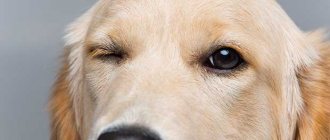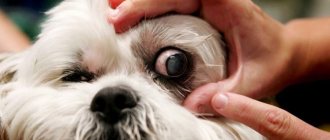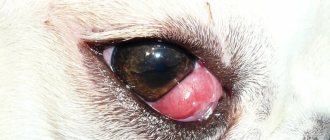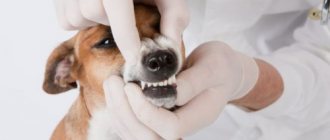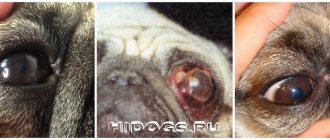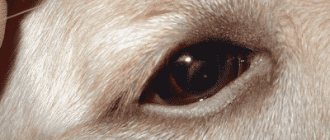The purpose of today's publication is to review the most common and effective medications used by professional veterinarians and amateur dog breeders to treat eye diseases in dogs.
Due to the abundance of reasons that can cause eye pathologies in pets, we will deliberately limit ourselves to a fixed list of diseases from which they most often suffer: injury to the eyelids, inflammation of the eyelids, corneas, conjunctiva and a number of others.
We will devote much more substantive and detailed publications to individual eye diseases in dogs with a detailed description of their etiology, symptoms, methods and means of treatment.
The names of medications, their dosages and conditions of use for the treatment of eye diseases in dogs are borrowed from textbooks and authoritative scientific works on veterinary medicine.
Medicines for eyelid injuries in dogs
The scope of medical care for eyelid lesions (Vulnus palpebrae) depends on the severity and nature of the disease or external injury.
Photo 1. Novocaine solution is most often used for pain relief for serious eye lesions in dogs
Severe physical damage to this organ, accompanied by cuts or tears in the tissue, requires immediate surgical intervention, usually accompanied by suturing.
A one to two percent solution of novocaine is most often used as an anesthetic.
To prevent the spread of infections, it is advisable to use antibiotics (exclusively as prescribed by a doctor), and as a means of disinfecting the cuticle of the eyelid and adjacent areas of the skin - “brilliant green” (a one percent solution of brilliant green).
In all cases of violation of the integrity of the eyelid, the first task is to rinse the wound with warm water and remove dirt deposits. The next step is to take the animal to the nearest veterinary hospital.
Medicines for the treatment of blepharitis (inflammation of the eyelids)
Demodex mite bites, careless scratching, bruises in the eye area, and eczema often lead to inflammation of the eyelids in dogs.
Externally, this disease manifests itself in the form of bleeding ulcers at the base of the eyelashes, interspersed with dried crusts and scales. The edges of the eyelids thicken and acquire a characteristic reddish tint.
The disease may be accompanied by loss of eyelashes, cicatricial inversion of the eyelid and profuse lacrimation.
Photo 2. The good old “green stuff” has more than once helped dog breeders in treating inflammation of the eyelids in their pets
If the cause of blepharitis is a tick bite, the drug ivomec, administered subcutaneously, is considered an effective treatment. The dosage is determined by the doctor and directly depends on the weight of the animal (from 0.1 to 1.0 ml for a single injection).
The use of most drugs should be preceded by a degreasing procedure for treating the eyelids with alcohol-ether, diluted in a ratio of 1 to 1.
For the complex treatment of eyelid inflammation in dogs, the following drugs are used:
- “brilliant green” (recommended for daily use);
- sofradex (a powerful remedy used only as prescribed by a veterinarian);
- betnesol;
- 10 percent calendula ointment;
- hydrocortisone acetate.
The treatment method for inflammation of the eyelids in dogs includes the introduction of medicinal emulsions of appropriate concentrations (methyluracil, syntomycin, gentamicin, oletethrin and others) into the conjunctival sac.
In old veterinary textbooks you can find recommendations for the use of special ointments based on mercury or zinc oxides to lubricate the eyelids:
- Hydrarg. oxyd. rubri 0.2. Vaselini 20.0;
- Zinci oxide. 0.5. Vaselini 20.0.
What medications to give a dog for eye diseases
In veterinary practice, both veterinary and medical drugs are used to treat one or another ophthalmic ailment:
| Disease | A drug |
| Conjunctivitis, including follicular: |
|
| For purulent discharge: |
|
| Corneal injuries: |
|
| Keratitis: |
|
| Corneal ulcer: |
|
With purulent discharge
The key to successful treatment for purulent discharge is thorough pre-treatment of the eyes with antiseptic agents before using medications. In case of purulent exudation, the veterinarian usually prescribes chloramphenicol drops, Bars, Iris. The drugs are based on broad-spectrum antibiotics.
Anandin is prescribed to strengthen local immunity and improve tissue regeneration.
For inflammation
A veterinarian prescribes the following medications for corneal inflammation:
| A drug | Active substance | Pharmacological properties |
| Leopard |
| Levomycetin is active against large viruses and most bacteria. Furacilin, being a strong antiseptic, has a bactericidal effect. |
| Sofradex |
| The antibiotic framecitin sulfate causes the death of microorganisms. Gramicidin destroys staphylococci. Dexamethasone contained in the drops has an anti-inflammatory effect and reduces allergic reactions. |
| Tobrex |
| The antibiotic has a wide spectrum of action and is effective against bacteria such as Escherichia coli, Proteus spp., Staphylococcus spp. |
| Diamond eyes |
| Chlorhexidine is active against bacteria and large viruses. Taurine is involved in redox reactions in corneal tissue. Succinic acid reduces swelling and inflammation. |
With antibiotic: Tobrex and others
To treat eye diseases of infectious etiology, antibiotic drops are prescribed to a sick pet. Such drugs as Floxal, chloramphenicol drops, Tobrex, Bars have a good effect.
For example, Tobrex drops basically contain an antibiotic that is active against many pathogenic microorganisms. The drug is used for infectious eye diseases.
Levomycetin for inflammation
Levomycetin (chloramphenicol), which forms the basis of chloramphenicol drops, is prescribed for inflammatory eye diseases - blepharitis, conjunctivitis, keratitis. An open bottle can be stored in the refrigerator for no more than one month. Apply the drug 1 drop in both eyes 3-4 times a day. The duration of the course of treatment is no more than 14 days.
Oftalmoferon
A veterinarian usually prescribes Oftalmoferon drops for the treatment of viral conjunctivitis, punctate keratitis, and adenovirus infection. The drug is dripped 3 times a day, 1-2 drops after preliminary hygienic treatment.
Taufon
Taufon eye drops are used in veterinary practice in the complex treatment of corneal ulcers, injuries, and cataracts. The drug contains taurine, which stimulates the regeneration processes of eye tissue. Taufon for dogs is used 1 drop 2 times a day for 7-10 days.
Levomycin drops
Tobrex Oftalmoferon
Taufon
Is it possible to drip Albucid
Veterinary experts do not recommend giving Albucid containing sodium sulfacyl to a sick dog. The product often causes a burning sensation and can lead to chronic conjunctivitis.
Sulfacyl sodium
Sodium sulfacyl is widely used in medicine, being an analogue of Albucid. Both drugs are not used in veterinary practice.
Watch this video on how to properly apply eye drops and eye ointment to a dog:
Medicines to treat conjunctivitis in dogs
Large breeds of dogs - Great Danes, Dobermans - are more often susceptible to diseases associated with inflammation of the conjunctiva (conjunctivitis).
The causes of the disease are extremely varied: from a banal lack of minerals and vitamins in the animal’s body (vitaminosis) and allergies to serious injuries or severe infectious diseases like piroplasmosis or plague.
The conjunctiva also becomes inflamed due to external chemical influences - alkali, acid, aggressive drugs, lime, as well as foreign bodies entering the eye.
Photo 3. Conjunctivitis causes discomfort in the dog, often accompanied by tearful and purulent discharge from the eyes
The cause of conjunctivitis can be the transfer of inflammation from adjacent areas of the skin.
The selection of medications to rid a dog of conjunctivitis depends on (1) its type (catarrhal, purulent, allergic, phlegmonous, follicular, etc.), which can only be diagnosed by a professional veterinarian, and (2) the causes of the disease.
For example, purulent conjunctivitis requires loading doses of antibiotics, the use of penicillin, synthomycin, tetracycline ointments and 30 percent albucid.
To treat catarrhal conjunctivitis, drip preparations with astringent properties are used (hydrocortisone, alum, one to two percent solution of zinc sulfate or protargol, resorcinol).
For follicular conjunctivitis, ophthalmic polymer films with sodium sulfapyridazine or kanamycin in combination with a conjunctival cauterization procedure performed in a veterinary hospital are considered an effective treatment.
To remove pus accumulating in the conjunctival sac, use a three percent solution of boric acid, rivanol (ethacridine lactate) in a concentration of 1 to 2000, or furatsilin (1: 5000).
For uncomplicated forms of the disease, the following medications are effective:
- teralen;
- dexamethasone;
- tinset;
- sofradex;
- betnesol;
- interferon.
How to easily conduct an instillation session?
- Sit comfortably, take the dog in your arms, and make him sit with his back to you. Also sit your large breed dog comfortably with its back to you. It is important that the pet does not see the jar of drops and other medical devices - solutions, napkins. Calmness in this matter is a faithful assistant; the dog should not be alarmed by anything.
- The first stage before instillation is cleansing the eyes and fur around. To do this, you will need warm water, which is moistened with sterile gauze swabs or cotton pads. This step is very important because it makes no sense if you put medicated drops into eyes that are full of pus.
- Next is the instillation process. Hold the jar of drops in your right hand, and with your left hand, slightly stretch your pet’s eyelid, slightly pulling back the lower part of the eyelid. It is in the lower eyelid that you drip the product.
- Make sure that the product gets into the dog's eyes. Usually the dog immediately begins to scratch his eye with his paw, feeling a burning sensation or irritation. Do not allow this to happen and do not let your pet go - you will have to put some drops into the second eye. Massage the eyelid to quickly absorb the drops, calm the dog - pet it.
- Do exactly the same manipulations. You can let your dog go with a clear conscience. In addition, to speed up your pet's recovery, use immunity medications for dogs.
Veterinarians often prescribe two different medications to treat eye diseases. Remember an important rule: use them at intervals of 15 minutes; if they are used one after another, the effectiveness will decrease.
A healthy dog's eyes without heavy discharge may develop small lumps in the corners of the eyes in the morning or throughout the day. They are removed with a regular cotton swab.
Some breeds require special eye care every day - pugs and Pekingese. The fact is that their organ of vision is structured a little differently: fluids from the eyes do not flow through the tear tracks, but overflow through the lower eyelid. As a result, unsightly stains remain on the fur of representatives of these breeds. Care involves cleaning the hair around the eyes with napkins. If the dog does not accept treatment, is too aggressive towards procedures, or is simply playful and restless, study the prices of calming drops for dogs and choose the appropriate professional product from the line.
A dog’s health and quick recovery from diseases sometimes depend on the competent actions of its owner. Use our advice - we wish your pets health!
One of the most commonly used medications for keeping pets is eye drops for dogs. And this is quite understandable. For our four-legged friends, eyes are more than just an organ of vision. It is also a “tool” for communicating with each other, with its owner. This is an indicator of the dog's health.
Various discharge from the eyes, their swelling, inflammation and other changes can indicate not only their infection, but also more serious diseases of the body. Therefore, caring owners always monitor the condition of their pets’ eyes and will never ignore any changes in them. If your pet’s eyes are red and constantly watery, or, even worse, fester, he has lost his visual acuity, or his eyes just need to be washed, drops can always help. What do you need to know about them?
Medicines for inflammation of the cornea (keratitis) in dogs
Inflammatory processes in the dog’s body can provoke clouding of the cornea, which can lead to complications in the form of abscesses and ulcers, leading to perforation of the cornea if the disease progresses unfavorably.
The damage to the cornea that occurs is replaced by connective tissue, resulting in the formation of a cataract (an opaque whitish spot) on the eye.
Effective treatment of an eyesore in a dog is possible only in a veterinary hospital.
In rare cases, spontaneous restoration of corneal transparency is possible due to resorption of the infiltrate.
It is customary to divide inflammation of the cornea of the eyes (keratitis) in dogs into:
- superficial purulent;
- deep purulent;
- superficial vascular;
- catarrhal;
- phlyctenulosis;
- point;
- superficial.
To treat keratitis, antibiotics, ointments or drops of hydrocortisone, and sulfonamides are used.
Accumulations of pus in the conjunctival sac are removed using solutions of penicillin, furatsilin, boric acid, furagin, ethacridine lactate.
At the stage of attenuation of inflammatory processes, the resorption of corneal opacities is artificially stimulated using tissue therapy, treating the cornea with yellow mercury ointment, dionin (from half to five percent solutions) or novocaine blockades.
Other drugs (acyclovir, solcoseryl, ophthalmic polymer films, dexamethasone, sofradex, betnesol, etc.) have also proven their effectiveness in the fight against the disease.
To avoid complications, the use of all of the above medications is permissible only with the agreement and approval of a veterinarian.
Popular eye drops for dogs
In veterinary practice, the following eye drops for dogs are used for ophthalmological problems:
| Drug name | Indications for use | Dosage |
| Diamond eyes |
| For a pet weighing up to 10 kg, 1 drop of the drug is instilled; if the dog weighs more than 10 kg, 2 drops are instilled. For a single eye treatment, the duration of the course is no more than 45 days (break 10 days). If the drops are instilled 2 times a day, then the course of treatment is no more than 20 days (a break of 7 days). When used three times, the drops are used for no more than 2 weeks (break 5 days). |
| Leopard |
| The product is used after cleaning the eyes with a cloth moistened with an antiseptic solution. For the purpose of prevention, the drug is instilled once a day, 1-2 drops. During the treatment course, 1-2 drops are dripped into each eye at least 3 times a day for 10-14 days. In case of eye injury and contact with a foreign object, drop 3-4 drops 3 times a day for 1-3 days. |
| Iris | Treatment:
Prevention after injuries and introduction of a foreign object into the eye. | When treating ophthalmological diseases, the drug is dripped 4 times a day for 7-10 days. For pets weighing up to 10 kg, one drop is instilled. If the dog weighs more than 10 kg, then 2 drops. For the purpose of prevention after injury or removal of a foreign object, instill 1 drop, regardless of the pet’s weight, 4 times a day for 3 days. |
| Optimmune | Treatment of autoimmune eye diseases - idiopathic keratoconjunctivitis sicca, plasmatic infiltration of the third eyelid and chronic superficial keratitis. | The ointment is placed in the subconjunctival sac 2 times a day in the form of a strip 0.5-1 cm long. |
| Korneregel | Eye gel (drops) is used to treat:
| In the form of drops of the drug, 1 drop is used 4 times a day. After preliminary antiseptic treatment, the eye gel is placed in the subconjunctival sac 2-3 times a day. |
| Anandin | Drops are used to treat keratitis of infectious origin. | Twice a day, 2-3 drops for 2 weeks. |
| Tsiprovet | In ophthalmology, the drug is prescribed for keratitis and other eye diseases of bacterial etiology. For prophylactic purposes, drops are used in case of ingress of a foreign object, eye injury, as well as before surgery and in the postoperative period. | For 7-14 days, the dog is given 1-2 drops in each eye 4 times a day. |
Diamond eyes
The drug is based on chlorhexidine, which has powerful antiseptic properties. Taurine and succinic acid included in the composition have a regenerating effect on eye tissue, improve blood circulation in the organ, and slow down the processes of corneal degeneration. The medicine is compatible with other medications.
Leopard for all ages
Chloramphenicol and nitrofural, which form the basis of the drug, have a broad bactericidal effect against many microbes and large viruses. When using the drug, you should avoid missing the next dose.
We recommend reading about the treatment of entropion in dogs. From the article you will learn about what medial volvulus is, the causes and symptoms of the defect, stages of pathology, and treatment options.
And here is more information about what retinal atrophy in dogs is and how to treat it.
Iris
The basis of the drug is gentamicin, a broad-spectrum antibiotic. In the case of a purulent infection, before using the drops, it is necessary to treat the diseased organ with an antiseptic solution.
Optimmune against swelling, dryness
The immunosuppressive properties of cyclosporine make it possible to effectively use the drug for the treatment of chronic superficial keratitis and other diseases of autoimmune etiology. Optimmune should not be used for fungal and viral eye diseases.
Korneregel
The pharmacological use of the drug is based on the regenerating properties of pantothenic acid. By stimulating healing processes, Korneregel is successfully used to treat burns and corneal injuries.
Anandin
Anandin immunomodulatory drops are most effective in the early stages of the infectious process. In addition to the antibacterial effect, the drug has pronounced regenerating and anti-inflammatory effects. Can be used in complex therapy with other drugs.
Tsiprovet
The drug, which has an antibacterial effect (it contains the antibiotic ciprofloxacin), is incompatible with other drugs that have an acidic reaction.
Diamond eyes
Leopard Iris
Korneregel
Optimmune
Anandin
Tsiprovet
Is it possible to drip Visine?
Veterinary experts do not recommend dripping Visin for eye diseases in dogs, since the drug has a pronounced vasoconstrictor effect.
Antimicrobial eye medicine for dogs Ciprovet
A popular antimicrobial eye medicine for dogs is Ciprovet; this medicine is effective for acute and chronic lesions of the conjunctiva and cornea of the eye of infectious origin. The drug should be used only as prescribed by a specialist, since Ciprovet has contraindications (atherosclerosis, damage to cerebral vessels). The drug is not suitable for treating newborn animals.




